Motor and Perceptual Development 0-7 years
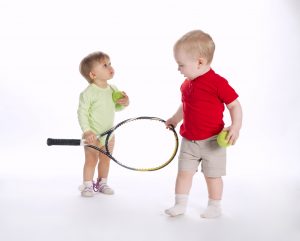
0 – 2.5 years: Existence/Needs/Autonomy
2.5 – 7 years: Will/Love-Sexuality/Opinions
Material is primarily organized from Britte Holle’s literature:
“Motor Development in Children”/ “Lege/idraets parat”/ “Lse/skrive parat”/ “MPU testen”
Translation: Babette Rothschld, M.S.W. May 1992
DEFINITION OF TERMS
GROSS MOTOR DEVELOPMENT
The newborn’s reflexes to the almost fully motorically developed child of 7 years. Reflexes, roll, sit, creep, crawl, stand, walk, hop, run, bike ride, skip.
HAND MOTOR (Fine motor)
Arm’s supination/pronation movements, hand grasp, eye-hand coordination. Grasp, release, throw/roll ball, stack blocks, eat, draw.
SIGHT/VISUAL PERCEPTION
Space, direction and distance judgement, separation of figure and ground, form and picture conception, color perception, eye-hand coordination, concept of the whole, visual memory.
EATING/SPEAKING ORGANS
Search/suck/swallow reflexes are the basis for development of eating and speaking organs. The sucking reflex is decreasing about the same time that the biting reflex is beginning (4-5months).
The biting reflex disappears a little at a time when chewing begins in ernest (ca.2.5 years). Head balance is important for eating/speaking organs.
Nursing, biting, drinking, sucking, blowing, whistling.
HEARING/AUDITORY PERCEPTION
Sound/language understanding: From reacting to near sounds, to more distant sounds with awareness of what it is that makes the sound and which direction it comes from. To being able to understand language sounds, remember words, names, understand simple stories. Concludes with understanding spoken language (that is, the child has developed an inner language.).
TOUCH/TACTILE PERCEPTION
Feeling sense – sense of touch – skin sensitivity – pain/temperature sense Recognition of shape, surface recognition, temperature sense, pain sense
KINESTHETIC SENSE
Position and movement sense – depth perception – proprioceptive sense
Body awareness.
Awareness of tension/relaxation – position of parts of the body – name parts of the body – direction – space – time – weight judgement – ability to move – sense laterally, difference of right/left
TALKING/EXPRESSIVE SPEECH
The first scream, crying, babbling, single words, one word sentences, etc., — eventually to correct language: pronunciation, understanding, grammar
PERCEPTION
Understanding that which is sensed.
The brain understands a stimulus and organizes it. This organized sense impression is used partly to immediately respond to the stimulus, i.e., a movement or words, and partly the impression is remembered and used later as experience.
First comes the stimulus, after the brain organizes the stimulus.
Understanding of the fragments, to an understanding of the whole (and then to action).
*NOTE: Though “Talking/Expressive Speech” is not an individual area, and is only sporadically mentioned under “Eat/Speech Organs”.
The following sections covers each age/phase in the above areas.

For an overview of the Emotional relational themes governing each developmental stage and how it affects character formation please read: The Seven Developmental Stages
EXISTENCE
BIRTH
Reflexes
Reflexes are characterized by getting the same response to the same stimulus.
1.Motor reflex/startle reflex:
Is provoked by, i.e., sound. The child twitches with the whole body/ “Stretches out.” Decreases around 3 months. (Some leftover through life, i.e. Shock reaction)
2. Blink reflex:
Lasts whole life.
3. Search reflex:
Provoked by stimulating corner of mouth. Head turns to stimulated side.
Disappears around 4-5 months.
4. Sucking reflex:
Provoked by, i.e., sticking finger in child’s mouth between the lips.
Disappears 5-6 months.
5. Swallow reflex:
Disappears about 2 1/2 years.
Hand’s grasp reflex:
Provoked by stimulating the palm. Decreases 2-3 months, then a conscious grasp movement develops. Vision must develop to the point where the child can “catch/grab” an object with his eyes before he can stretch out to grasp with his hand.
6. Foot’s grasp reflex:
Provoked with pressure to pads of the foot. Toes grasp/bend. This reflex must disappear for the child to stand securely — disappears 11-12 months.
7. Babinski reflex:
Provoked by grazing bottom of the foot (little toe side to heel). The big toe bends upwards (the toes may spread). Disappearance important for gait — 17-18 months.
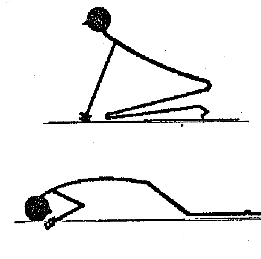 8. Symmetrical Tonic Neck Reflex = sym. TNR
8. Symmetrical Tonic Neck Reflex = sym. TNR
Disappears about 3-4 months.
As the name implies, the movement is symmetric in the two body halves (left/right) Tonic
Neck reflex = tension in neck muscles provokes the position of the limbs.
Reflex is evoked:
When the neck/head bends backward (extends), the arms extend in all
joints (also the fingers) and the legs flex in all joints.
The opposite can also occur: When the head is bent forward (flexed), the arms flex in all joints (also the fingers) and the legs extend in all joints.
The Symmetric Tonic Neck reflex will prevent the child from crawling.
At 10-11 months, the child can normally stand on all fours with weight evenly distributed between arms and legs, with vertical arms and legs, and can hold this position whether head is flexed or extended. Now the reflex is under control and the child can crawl in cross pattern. (Spastic and other brain damaged children can have a TNR so powerful that it is impossible for them to crawl or walk).
9. Asymmetrical Tonic Neck Reflex = Asym. TNR
Disappears 3-4 months.
Reflex is evoked:
The child turns, e.g. the head to the right, the right arm extends and the left flexes. Turning the head to the left evokes the opposite reflex. Can also be provoked by bending the arm so the head turns to the opposite side. The legs follow the same pattern, but to a lesser degree: if the right arm extends, so will the right leg, and vice versa. Reflex not present in all infants, but if there, it should be under control around 3-4 months.
The older child: If reflex still present, is a sign of abnormality.
If it is strong, it will hamper the child’s further development:
-Rolling from back to stomach. The child turns the head in the direction of movement and the arm stretches out, preventing the roll.
-Feeding himself. The food is held in the bent hand and the elbow bends as he moves the food to his mouth, then the head turns away from the bent arm, and the food.
-examining objects close-up. The hand bends to hold the object, the arm bends to bring it near the eyes, and the head turns away from the bent arm.
Can be checked as follows: In all-fours position: flex the head, if the limbs bend = symmetric. Turn the head: if limbs stretch and bend = Asymmetric.
EXISTENCE/NEEDS
0 – 1 month
Gross motor
- Massive movements. All joints bent. Prone: Places head to one side for air. Prone: Lifts head briefly.
- (Asymmetrical body position)
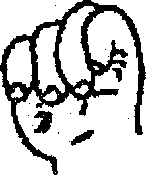 Fine motor
Fine motor
- Hand development from 0 – 1 year:
- 3 finger = 3 months.
- 5 finger = 5 months
- 2 finger (pincer grip) = 10 months.
- Pronated hand. Thumb grasped in hand.
(Begins to differentiate thumb at 2-3 months.)
Visual Per.
- Blink reflex. Beginning fixation. Can fixate on large, light surfaces.
Auditory Per
- Reacts with fear to loud sounds.
1 -2 months
Gross motor
- Prone: Kicks spontaneously with legs, almost straight knees. Supine: Head to one side – arms/legs “flail about.”
Visual Per.
- Eye coordination beginning. Eyes often move together. (Sees from periphery to center.
Auditory Per
- Listens for sounds (and reacts, i.e., becomes quiet or cries).
2 – 3 months
Gross motor
- Supine: Can hold head centered. Prone: Head lifts 45°
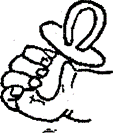 Fine motor
Fine motor
- Ulnar-palmar grasp (inner rotated/pronated) (fingers bend most on little finger side of hand) Grasp reflex decreasing.
Visual Per.
- Fixation: Can follow object that moves up and down (because head balance good), but cannot follow an object that crosses the center line.
- “Grasps” with eyes, before grasping with hands.
Eat / Speech organs
- Sucks on everything. Eats from spoon.
- Simple babble/chatter.
Auditory Per
- Recognizes mother’s voice. Turns head towards sounds.
- Social smile (not dependent on the adult’s smile).
0-3 months
Summary:
- The child is completely dependent on the parents to provide for all of its needs for touch, contact and help to move.
- The child begins to have body awareness and self-confidence.
- The child’s movements are massive, mostly in flexion, and symmetrical.
- Head holding develops in the prone position from short side-turned reflex lifts to the child being able to hold its head centered and lifted 45 – 90°. Supine the child can straighten the head from side-turned to centered position.
- When the child is raised from lying to sitting, we see that the head is starting to fall backwards, but around 3 months of age, the child can lift the head a little way and the head follows the body.
- Rolling movements are passive. In the beginning without torsion of the spine, but during these months, the spine begins to rotate.
- The child’s grasp is ulnar reflex.
- The child’s mouth and cheeks are cushioned with fat. The sucking pattern becomes distinct already during the first days, and the connection between sucking and the body’s rhythms is established.
- The child notices that it is worthwhile to make sounds, and can both “talk” and listen.
- The child works with reflex movements; neck, back, buttocks and leg muscles; feeling, balance, movement, sight, taste and smell senses.
NEEDS
3 – 4 months
Gross motor
- Rolling from side to back and reverse.
- Supine: rotation in neck — turning the head, the body DOES NOT follow.
- Good head balance.
- Supine: Head follows in the same plane as the body when lifted up by arms.
- (When the child can lie with the head in center, the field of vision changes
- drastically.)
- Prone: Stable lifting head to 90° (arms and fingers bent).
- Asymmetric tonic neck reflex disappears.
- Head balance
- If the child doesn’t establish a good head balance as soon as possible, further development is not possible, because rolling, rising from lying and many other movements begin with lift of the head.
- Head balance develops in the infant in connection with sight, if there isn’t enough to see, there is not motivation to lift the head.
- Lying prone, the baby can, from birth, lift the head enough that it can turn it to get air. When carried in the mother’s arms the child is supported in the beginning with forehead towards her shoulder, but soon it can lift and control the head in vertical – position.
- At around 3.5 months, the child can lift the head, while prone, 90°.
- Binocular vision and fixation is now good.
- In supine position, the baby can first lift the head separately at about 5 months.
- Head balance is connected to equilibrium and balance, also with eye movement and kinesthetic sense
Fine motor
- Grasp unsure. (Grasp reflex decreasing)
- Pronated hand. Thumb grasped in hand.
(Begins to differentiate thumb at 2-3 months.)
Visual Per.
- Beginning to follow with eyes when the center line is crossed (because the fixation reflex is more developed and asymmetrical tonic neck reflex is under control).
- Follows an object that goes slowly around in a circle.
- Recognizes the adults that cares for it.
- Auditory Per
- Reacts positively to, i.e., quiet music (i.e. music box).
- Smiles when adult talks mild/lovingly.
- Reacts negatively to noise (cries).
Eat / Speech organs
- Feeds with spoon. Child actively takes food from spoon (closes lips well around it).
Tactile Per.
- Begins to touch and push things that hang over the bed.
Kinesthetic Sense
- Sees and plays with hands in center position.
NEEDS
4 – 5 months
Gross motor
- Supine: Pulled up to sit – the child lifts head and shoulders first = the child helps with the lift.
- Beginning weight bearing (the feet on solid surface).
Fine motor
- Handles bigger objects with both hands at the same time.
- Begins, with difficulty, to LET GO (lays object on the table and then letting go).
Visual Per.
- Reaches out after objects.
- (Arms are now so competent that they take over reaching /grasping movement. Eyes used together with arms (eye/hand coordination) -therefore, eye movements will not be described separately anymore.)
Eat / Speech organs
- Sucking reflex disappears.
- Biting reflex emerges. (Puts everything in mouth and bites on it.)
- (Biting reflex can be consciously restricted at about 2.5 years.)
- The child makes loud, babble-gurgle sounds.
- Plays with sound, as it will later play with things.
Auditory Per
- Feeds with spoon. Child actively takes food from spoon (closes lips well around it).
Tactile Per.
- Listens more consciously
Kinesthetic Sense
- Puts everything in the mouth
NEEDS
5 – 6 months
Gross motor
- Prone: Lifts upper body: supported on STRETCHED arms and STRETCHED fingers. (This position expands the chest, effecting sound. Supination/Pronation is exercised in this position. From here, the child begins to use its fingers more and more for investigating things.)
- Sits on lap with straight back (light support to lumbar).
- Prone: ROLLS FROM STOMACH TO BACK. (Upper body conducts the moment; the legs are passive)
- Rolling movement
- Roll from stomach to back, i.e. over left side: It is easier to roll from stomach to back then the opposite because the arms can help and because head balance is developed earliest in prone position
- Head lifts and turns to the right.
- arms are first bent and the child supported on the forearms.
- Right arm stretches next as the left-hand pushes toward the floor.
- The right leg lifts backwards over the left and gravity helps to roll the whole body onto the back.
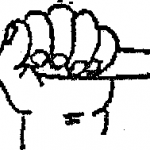 Fine motor
Fine motor
- Radial-palmar grasp.
- Object is held in palm of hand and all fingers take part in the grasp, also the thumb and index finger (radial).
- Wrist is in center position.
- Can move object from one hand to the other. (Practices letting go).
- Can strike/beat with the object up and down.
Visual Per.
- Sees an object on the table and reaches out after it = can distinguish figure from ground.
- Can distinguish strangers from known persons.
Eat / Speech organs
- Drinks from a cup with help.
- Sucking reflex disappears.
Auditory Per
- Listens to conversations
Tactile Per.
- Investigates now, also, with fingers — not only with mouth, but mostly with mouth.
- Shows affection/attachment.
Kinesthetic Sense
- Plays with own toes
4-6 months
Summary:
- The child continues to be dependent on the environment, but begins, also, to stimulate itself.
- It begins to investigate itself and to form a sense of its own body.
- It begins, also, to understand that its actions effect the environment.
- We see flexation patterns disappearing. When the child lays prone, the hands and arms are stretched. The head is lifted high and head balance is good.
- It rolls actively and with torsion.
- The child plays with hands and feet and begins to develop eye/hand, eye/foot, and eye/hand/foot coordination.
- It reaches precisely and grasps actively with the whole hand.
- Eyes, Ears and mouth investigate what is held in the hand and the child connects sight and hearing with experiences of touch to the mouth and fingers.
- The child’s use of gestures and mimicking lays the foundation for the later connection between body and speech rhythm.
- It realizes also that there is a relationship between mimicking, the sensations in the tongue and oral cavity, and particular sounds.
- The child works with the body’s twisting movements; neck, shoulder, back and arm muscles; the hands strength and suppleness; eye/hand, eye/foot and eye/ hand/foot coordination; and the senses of touch, movement, balance, hearing and sight.
NEEDS
6 – 7 months
Gross motor
- Supine: Head lifts (without shoulder lift) – i.e., when the child looks for something.
- Sits on lap without lumbar support (but with wide spread legs and possible support on its arms).
- Supine: ROLLS FROM BACK TO STOMACH (full roll function at 8 months).
- Fall reflex: Moves arms FOREWARD
- LANDAU(“flying”) reflex — The child moves/rotates around own axis/navel. (Reflex
- is released about 4-1 5 months by lifting the child in the air.)
- Rolling from back to stomach, i.e. over the left side:
- Head lifts and turns to left, Right arm and leg are carried slightly bent in over the body toward the left, and gravity helps to bring the child onto the stomach, the arm underneath, here the left, is held a little back in under the body, so it doesn’t get in the way during rolling.
Fine motor
- Reaches/grasps confidently.
Visual Per.
- Follows rolling ball with sight.
Eat / Speech organs
- Chews up and down.
Auditory Per
- Turns head towards calling voice
Tactile Per.
- Puts own toes in mouth (eye/foot and eye/hand/foot coordination)
Kinesthetic Sense
- Smiles at own reflection in mirror
7 – 8 months
Gross motor
- Falling reflex: Arms go out to BOTH SIDES.
- Weight bearing: Almost full weight bearing.
- Walking movements: The child holds tightly to surface with feet. Often walks on toes.
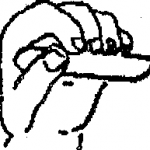 Fine motor
Fine motor
- Finger grasp begins (all 5 fingers, free of palm). Scrapes/pushes, i.e., resins from the table into the palm with the fingers.
- Throws/pushes everything onto the floor.
Visual Per.
- Watches an object fall.
Eat / Speech organs
- Eats more solid food, i.e. pieces of bread, Cheerios.
- Holds food with fingers and bites, i.e. a banana.
Auditory Per
- Loves to make sounds, i.e. use a rattle.
Tactile Per.
- Pushes irritating clothes off, i.e. a hat.
Kinesthetic Sense
- REACHES ARMS FOREWARD/UP to be lifted up. Plays pat-a-cake.
NEEDS/AUTONOMY
8 – 9 months
Gross motor
- Sits a long time on the floor with a straight back (turns head without loosing
- balance).
- Stands up
- Stands with support.
- Foot’s grasp reflex disappears
- Can sit on heels
- CREEPS
- Creeping:
- Head is lifted from the floor
- Sight is forward in direction of movement, towards the goal
- Chest remains on the floor
– Elbows bend - The hands lie flat on the floor with spread fingers pointed forwards
- Hands are placed out to the side
- The first hand that will work is held about forehead height during foreward movement, the whole hand pushes towards the floor while the other hand/arm is almost passive, but is pulled forward along the floor so that it can come in position for the next step”.
- The stomach and hips lie flat except when the one hip lifts a little as the leg bends.
- The knee bends approximately 90°.
- The ankle of the bended leg is bent severely and the foot is placed a good distance from the leg that is straight
- The ankle of the straight leg is also straight.
- The straight leg must not inner rotate too much, because it must soon rotate outward and bend.
- “steps” should be equally long on left and right sides, the result being: a cross-movement pattern, with opposite arms and legs working together to move the body forward,
- The movement becomes rhythmic and eventually,
- Automatic
Fine motor
- LETS GO of objects by request.
- GIVE/TAKE play (gives and takes back)
- (The child practices in letting go with a straight arm)
- Hits two things at each other in the air
- Pincer grip begins.
Visual Per.
- Finds hidden objects, i.e. under a napkin.
- “Hide and seek” play begins
- (Can hold representation picture a short time — object constancy).
Eat / Speech organs
- Mama/Dada (sounds, not words in meaning)
- Hears own sounds and repeats them.
Auditory Per
- Understands single words WITH gestures (understands mostly body language)
Tactile Per.
- Puts own toes in mouth (eye/foot and eye/hand/foot coordination)
Kinesthetic Sense
- Examines food with fingers/hands (hits and smashes food)
Imitation of sounds depends more and more on greater ability to separate sounds (auditory perception) and thereafter on greater, motor ability to create and make sounds. Also: Motor and language development belong somewhat together (like all the other areas of perception).
7 – 9 months
Summary:
- It is important for the child to be able to move freely on the floor. It learns new movements, using them more precisely and with greater strength.
- The child gets many new and surprising experiences and needs, therefore, for the adult to sets limits.
- The child has control of its head.
- It creeps in cross pattern, sits on heels and stands on all fours.
- The child sits, now, without support and can reach and turn in all directions.
- It can also shift from lying to sitting.
- The child gathers with fingers, uses pincer grip, can turn wrist and examine all details.
- The symmetric patterns are phased out.
- The child plays give and take.
- It has a beginning thread of independence and begins to learn that things exist, even when they can’t be seen.
- The child uses new and longer sound combinations that is training for different tones: loudness, length and strength.
- It understands simple requests.
- The child works with: The large muscles on the back and front of the body; muscles in arms, legs hands and feet; turning and suppleness in spine; cooperation between the two body halves in rhythmic movement; suppleness in hands and feet; turning the wrist; eye/hand coordination; falling reflex; and senses of touch, balance, movement, sight and hearing.
NEEDS/AUTONOMY
9 – 10 months
Gross motor
- Lifts self from supine position through prone position to sitting. Sits on heels: Pulls self forward with hands and help of stretched arms.
Fine motor
- Moves an object forward and back in horizontal plane.
Visual Per.
- Recognizes many things.
- Begins to imitate movements it sees.
- Grasps/examines objects first with eyes and after with hands and fingers.
- In the next couple of months, the field of sight develops dramatically — with first sitting position and after, standing where good balance allows the child to look behind.
Eat / Speech organs
- Imitation of movements that make sound, i.e. clicking with tongue, or making sounds with fingers on lips.
- Development of tongue and lips. Language sounds become clearer. Imitates sounds even though it doesn’t understand the meaning.
Auditory Per
- Understands single words with gestures.
Tactile Per.
- Feels and investigates all objects — fingers active (table/closet/purse, etc.).
Kinesthetic Sense
- Imitates movements, i.e. stir with spoon, put blocks in a cup.
NEEDS/AUTONOMY
10 – 11 months
Gross motor
- Full weight bearing.
- STANDS – held by one hand
- Shifts from sitting to lying
- Pulls self up to STANDING from sitting
- Walks a few steps — held by both hands
- Falling reflex: BACKWARDS
- CRAWLS
- Crawl
- Head lifts
- Sight straight forward towards goal
- elbow straight in support phase
- Wrist bent fully backwards in support phase
- Fingers slightly spread, stretched and pointing forward
- Hands shoulder-width apart
- Hands and knees are back-length apart
- Lumbar swayed
- Calves and feet parallel
- Ankle extended
- “Steps” both with arms and legs should be equally long on each side so crawl is straight.
- Should be cross pattern, e.g. opposite arm and leg going forward at the same time goes forward a fraction of a second before the leg)
Fine motor
- Sticks index finger in all holes (eye, nose, toys, etc.) Pincer grip developing.
Visual Per.
- Beginning to judge distance and direction.
- (i.e., see a toy and move to get it).
Eat / Speech organs
- Begins to use sounds/”words” for particular things. Organs
Auditory Per
- Begins to be able to concentrate on something WITHOUT being distracted by normal background noise.
- Can do simple things by request, i.e. get a particular object from a particular place.
Tactile Per.
- Index finger differentiates, i.e. pointing, touching.
- Returns kiss and hug. Snuggles with adult.
Kinesthetic Sense
- Wants to be out exploring, experiencing. Won’t remain in playpen or sit nicely on the chair.
Parallel play/playing alongside with other children begins. They imitate each other’s activities. This form of play/contact is of an experimental nature and is the most important all the way up to 3 years.
There are often conflicts, because the child will have exactly the same or do the same as the other child. Might push or pull it, not to “hurt”, but because it doesn’t yet experience the other as a person, doesn’t differentiate between persons and things — they are treated the same.
It is first when the child masters language and has integrated its own identity (awareness of self), that it begins to cooperate with others = play together.
NEEDS/AUTONOMY
11 – 12 months
Gross motor
- WALKS a few steps — held by both hands
- Walks sideways (supported by furniture)
- STANDS a few seconds without support
- Foot’s grasp reflex disappears
- Rough analysis of walking:
- 3 rotations on own axis for each step:
- Left leg moves forward one step
- 1st. rotation: left hip swings forward with the leg, e.g. the whole hip turns a little. This occurs partly in the hip joint, but there is also rotation in the spine. If the whole body is to follow this rotation, the shoulders and head turn to the right, but that would be impractical.
- 2nd. rotation: The shoulder and head turn opposite the hip, e.g. the left shoulder turns back and the right forward. Arms are relaxed and swing along. If the head followed with the shoulders it would point towards the left, but it is more practical to see ahead when walking forward.
- 3rd. rotation: The head rotates to the right, e.g. straightens forward, and doesn’t follow the rotation of the shoulders.
- At the same time, there usually is a side lumbar bend when the leg lifts from the surface, the cause of the hip lift. This side bend compensates higher up in the spine with a side bend to the opposite side.
- Foot action (by Britta Tolle)
- The heel is set down
- There’s a roll over the arch
- Toes spread at the same time
- Take-off on pads of the foot
- Toes grasp and shove off/the big toe releases last.
- Knee and hip are extended during takeoff, and after, the muscles of the back of the leg (calf, thigh and buttocks) are contracted.
- 3 rotations on own axis for each step:
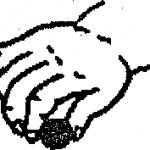 Fine motor
Fine motor
- Pincer grip quick and sure. Good opposition. Supinates easily. (Thumb opposition fully developed 5-6 years). Can FREELY leg go and let things fall.
Visual Per.
- Begins to look at pictures.
- (First distinguishes 3 dimensional objects. After, 2 dimensional figures) (First about 1 year that the child understands that an object is the same seen from different angles, at different distances, and against different backgrounds = FORM CONSTANCY)
- Recognizes and understands simple things and situations from daily life.
Eat / Speech organs
- Bites whole pieces of bread with crust.
- Begins to experiment with blowing (i.e., oatmeal on spoon)
Auditory Per
- Waves goodbye. Reacts to “Where is your cup?”
Tactile Per.
- From now on the child senses more and more with fingers.
Kinesthetic Sense
- Begins to help with dressing, i.e. reaches arms forward toward coat.
- It is easier to take clothes off than on, i.e. pull zipper down, unbutton.
In its first year the child has developed from being totally helpless to being able to handle a few situations itself. The child has learned to interpret its senses and has had a lot of perceptual experiences that become more and more clear and conscious. This means it can more and more use its experience in more complicated activities.
Sense impressions and concept pictures become organized together as a whole, i.e. to a complete picture of mother who is clearly distinguished from other people, or, i.e. hide and seek play that is a precursor to being able to hold a concept picture a short time.
10 – 12 months
Summary:
- The child’s independence increases. It becomes more curious and mobile. The child crawls in cross pattern. The hands are stretched/slightly bent, the head held high with movement free in all directions.
- It rises to stand with help of furniture and learns about height differences.
- The child gets to know the relationship between body position and how much room it takes up.
- The child’s grasp is slightly inner rotated and from above.
- It works with finding differences and similarities.
- It imitates eagerly and plays with sound and movement, and is good at expressing itself with the help of gestures and mimicking.
- At about one year we hear the first word that represents a whole sentence.
- The child works with: The large muscles on the front and back of the trunk; muscles of the arm, leg, hand and foot; torsion and side bend in the spine; cooperation between the two halves of the body in rhythmic movements; suppleness in hands and feet; muscles in lips, mouth and throat; eye/hand coordination; and senses of touch, balance, movement, sight and hearing.
NEEDS/AUTONOMY
12 – 15 months
Gross motor
- STANDS alone
- Sits on floor (with a bump) from standing
- WALKS ALONE – wide stance (= without rotation. With slightly bent knees, hips and ankles, and with arms lifted)
- Rises from supine position – through prone position – to standing
- Stands on knees (without support of hands)
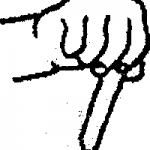 Fine motor
Fine motor
- Top grasp (pronated)
- Rolls a big ball – non-directional.
- Builds tower of 2 blocks
Visual Per.
- Points at things.
- Finds something that has, i.e., rolled under the table
Eat / Speech organs
- Eats with a spoon, but spills a lot.
- Drooling ends
Auditory Per
- Reacts to own name. Understands each person and object has a name.
Tactile Per.
- Senses more and more with fingers, because nerve endings in finger tips are more developed.
Kinesthetic Sense
- Beginning hand dominance, e.g. using mostly one hand.
- (First clear hand dominance about 2 years when the child begins to talk.)
NEEDS/AUTONOMY
15 – 18 months
Gross motor
- Squats and rises without support, i.e. gets something from the floor. Crawls up steps
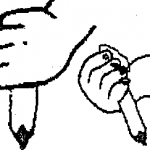 Fine motor
Fine motor
- Cross palmar grasp (pronated/inner rotated). (Thumb turns down).
- Cross grasps with spoon, holds against palm. Often high up.
- (Movement in shoulder, elbow, forearm = gross motor. No movement in fingers).
- Later adult (supinated) grasp begins at this age.
- Begins to throw ball, non-directional.
- Builds tower with 3 blocks.
Visual Per.
- Can point in book correctly, i.e. “where is the cat?”
- Finds particular toys in pile, i.e. “get the car.”
- Can get particular things and show them (without request).
Eat / Speech organs
- Drinks from a cup. Eats normal food, including meat cut in pieces.
- (It is important for speech that the child has food it must really chew, to exercise muscles necessary for speech.)
Auditory Per
- Notices strange sounds, i.e., from another room.
- Understands simple sentences without gestures, i.e. “Do you want milk?”
Tactile Per.
- Likes to hold soft things: Stuffed animals, blanket, etc.
- Reaches towards a sore place.
Kinesthetic Sense
- Crawls on and off furniture.
- Can steer wagon free of obstructions.
- Moves to music — up and down.
- Insists on dressing and undressing self
AUTONOMY
18 – 21 months
Gross motor
- Runs stiffly on flat feet.
- Walks backwards.
- Babinski reflex disappears. (Prerequisite for good development of foot for walking).
- Walks sideways
- Walks on knees without support of hands.
- ‘Walks upstairs — held in hand
Fine motor
- Builds tower with 4 blocks
Visual Per.
- Points at distant things.
Eat / Speech organs
- Eats nicely with spoon.
Auditory Per
- Knows at least 8 objects by name, “Give me ….”
- Continually better to recognize and localize sound, i.e. distinguishes doorbell from telephone.
Tactile Per.
- Sense of pain develops.
- (Understands that touching the stove can hurt).
Kinesthetic Sense
- Knows at least 3 parts of the body, i.e. “Where is your arm?” Understands meaning of, i.e., “Stretch your leg.”
AUTONOMY
21 – 24 months
Gross motor
- Starting to be able to stop suddenly while running.
- Shifts direction suddenly.
- Can kick a ball while standing without falling over. “Hops” on flat feet. Feet leave the floor at the same time. Goes up stairs – holding the banister.
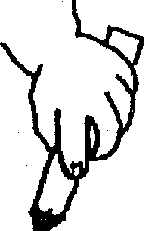 Fine motor
Fine motor
- STRETCHED.
- Hand steady. Wrist participates.
- Throws ball in particular direction, but without precision or strength. (This requires back swing of arm which is not mastered until arms swing during walking.)
- Builds tower with 6-7 blocks.
- Eats nicely with fork.
Visual Per.
- Turns pictures right-way-up.
- Begins to point and name at the same time (impressive language well developed)
Eat / Speech organs
- Can blow out candle
Auditory Per
- Repeats last word of adult’s sentence
Tactile Per.
- Turns one magazine page at a time.
Kinesthetic Sense
- Knows 5 -14 parts of the body, “Where is your…”
- Understands directions: in/out (“Go in/out of the room”).
- Understands directions: up/down (“Reach your arms up/down”). Loves to play hide and seek.
1-2 years
Summary:
- The child takes his first steps. The arms are lifted high, the gait is forward and wide. The whole foot meets the surface. The child ‘s complete concentration is on walking. Eventually the walking becomes directional and the child can hold its balance with lowered arms.
- The child stands upright from all fours.
- It can shift from standing to crouching without losing balance.
- The child gains a secure body awareness and knows how much space it takes up in different movements.
- At about 18 months the child has a preferred hand.
- At about 2 years we see the child stretching the index finger and using tools more precisely.
- Tactile sense and eye/hand coordination is developed so the child no longer needs to examine with the mouth.
- The child has a secure understanding that things exist even though they cannot be seen.
- The child understands that each thing has a name. In the beginning, it connects the name to a particular object, but later it understands a name can describe a whole group.
- The child endeavors to pronounce words correctly.
- The child works with: the large muscles on the front and back of the trunk; arm, leg, hand and foot muscles; suppleness in hands and feet; outer rotated positions of the hand; eye/hand, eye/foot and eye/hand/foot coordination; fine movements in the fingers; rotation of the trunk while standing; muscles around and in the mouth, tongue and throat; and senses of touch, balance, movement, sight and hearing.
AUTONOMY/WILL
2 – 2.5 years
Gross motor
- Foot articulation when walking (heel-toe gait, broad stance ceases)
- (First 4-5 years: free walk with full rotation)
- Rides a tricycle.
- Hops on flat feet which come fully away from floor (without support)
Fine motor
- Inner rotated finger grasp, FREE of palm.
- Wrist more active. Movement in wrist/elbow/shoulder.
- Cross palmar grip with stretched index finger (when drawing).
- Fingers stretch to size of object it takes (not fully as before)
- Catches big ball with both arms, pulls in towards chest.
Visual Per.
- Distinguishes colors: red, yellow, green, blue, black, white. (Maybe not by name, but can, i.e., place red with red.)
Eat / Speech organs
- Grinding chewing, moves food with tongue from one side to the other.
- Chews alternately on both sides.
- (All teeth in place)
- Can hold and bite an apple
Auditory Per
- Understands and likes simple stories.
- Follows requests (without gestures), also things that are not the child’s own,
- i.e., “Go in the hall and get my purse”.
Tactile Per.
- Distinguishes shape without help of sight, i.e. show the child 3 things (doll, car, spoon), hand to child under table.
- Child can recognize object through touch.
Kinesthetic Sense
- Knows 15 — 19 parts of the body. Can name or point to them. Understands directions: under/over/on/in/beside
WILL
2.5 – 3 years
Gross motor
- Walks freer (= good articulation of foot)
Fine motor
- Pours into a cup.
- Builds tower of 8 blocks.
Visual Per.
- Names a single color correctly
Eat / Speech organs
- Biting reflex decreases. Blows/sucks with straw.
- Begins to say I/ME/YOU.
Auditory Per
- Understands actions described in pictures.
Tactile Per.
- Temperature sense developed. Understands/senses hot/cold water.
Kinesthetic Sense
- Knows 20 -24 parts of the body (names or points)
- Understands direction: “Go around”
- Senses passive movements without help of sight, i.e., adult bends child’s finger under the table — the child can do it actively itself afterwards.
- Knows its sex (boy/girl)
Abstract Reasoning
- Counts to 2 (“Give me 2 blocks” (out of many), or “How many legs do you have?”)
- Can sort by shape (i.e., “Put all the ones like this here, and all the ones like that there”.)
- One to one correspondence: “Give one candy to each of the children”
- At 2 years the child understands ideas as “none”/”many” and can estimate the amount of 1, i.e. give me one block — out of many.
- 2 – 2.5 years can count to 2 or more.
- Becoming toilet trained (“hold”/”let go”)
2-3 years
Summary:
- The wide gate disappears. The child walks with more foot articulation but without arm swing.
- It throws in a particular direction, but still without strength.
- Tools are held with fingertips in brush-grip.
- The child chews with grinding movements and can blow in and drink from a straw.
- The child is still very dependent on a model to imitate, but begins to role play.
- Babble disappears, replaced by words and sentences.
- The child loves rhymes and to rhyme and begins to be able to rhyme along with known rhymes.
- It understands and follows prepositions, and transforms concrete actions to language.
- The child works with: the large muscles on the front and back of the trunk; arm, leg, hand and foot muscles; suppleness in hands and feet; rotation in wrist; fine movements in fingers and feet; and senses of touch, balance, movement sight and hearing.
WILL/LOVE-SEXUALITY
3 – 4 years
Gross motor
- Runs correctly (= “floats” a second over the ground)
- Small jump forward with feet together.
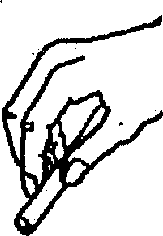 Fine motor
Fine motor
- Outer rotated finger grip
- Plays with big ball
- (Catches underhanded throw with both hands and spread fingers)
- Plays with little ball
- (Catches underhanded throw with both hands held like a bowl.)
Visual Per.
- Copies block building /3 blocks.
- Names 2 colors correctly.
Eat / Speech organs
- Can consciously hold water in mouth without swallowing it. (i.e., doesn’t swallow toothpaste while brushing teeth)
Auditory Per
- Short-term memory expands, i.e., can follow 3 simple instructions: “Go in the kitchen, put this glass on the table and bring back a spoon.”
Tactile Per.
- Child expresses when it is too warm or cold
- Child can distinguish touch to its body without help of sight, one place at a time
- (The adult touches, i.e. the knee, with child’s eyes closed, and child names or points to where its being touched.)
- Can distinguish form and consistency without help of sight
- (i.e., The child recognizes through touch different things it knows under the table)
Kinesthetic Sense
- Names 25 – 34 parts of the body
- (i.e., can go under a rope (without touching it), that is stretched out in different heights: shoulder, elbow, stomach, etc., and bend the right amount, neither too little nor too much).
- Space perception: i.e., “Look around the room, now I’m going to blindfold you. Point to the window, door, closet, etc.”
- Lateral perception.
- (Can sense that its body has two sides/halves, that often do different things, later can distinguish right and left.)
- Weight judgement: can distinguish” heaviest” and “lightest” of three things with 100gr. interval
- Body awareness well developed
Abstract Reasoning
- Knows difference in size (“Are these two equally big/long?”)
- Counts to 5 or more
- Two to one correspondence: “Give 2 pieces of candy to each child”
- Girls can estimate the amount of 3 (without counting) — (Boys, 1 year later)
- Basically dresses self without help.
WILL/LOVE-SEXUALITY
4 – 5 years
Gross motor
- WALKING: The body rotates freely = front gate gone, and arms swing freely.
- Stands on one leg (without support for a short time, maybe only on dominate leg)
- Girls – 3-4 hops forward on one leg – without support (boys do it later)
- Can rise quickly from lying, like adults.
- (Rolls up on side/bends legs and may support with hands on the floor)
- Girls jump forward on 2 legs (Boys later)
Fine motor
- Low writing/drawing grip with forearm resting on table.
- Big ball: Bounces ball on the floor and catches with both hands and spread fingers.
- Little ball: Underhand throw. Catches with both hands but DOESN’T stand waiting with arms forward before the throw.
Visual Per.
- Can name colors: red, orange, yellow, blue, black, white.
- Can distinguish (but not name) shades of red, green, yellow, blue.
- Recognizes and understands traffic signal.
- Concept of the whole: Can, i.e., complete drawing of circle and rectangle presented as only half finished.
Eat / Speech organs
- Can answer correctly, “What are you chewing with?”
- Asks unendingly, “Why”/”how?”
Auditory Per
- Long and short-term memory increases steadily
Tactile Per.
- Pain sense: can point to and say where it hurts
- Can sense touch in two places, without help of sight.
- (i.e., touch the child on knee and cheek at the same time)
- Can distinguish shape without help of sight (i.e., Square/round/triangle cut from cardboard and identified with fingers.)
Kinesthetic Sense
- Can imitate movements (i.e., the adult stands with hands crossed on each knee — does not laterally reverse)
- Understands tension/relaxation (i.e., “make yourself as stiff as a stick…as limp as a rag doll”)
- Understands directions: forward/backward/sideways/front/behind Area sense: “Stretch so you are really long/bend so you are really little” Time sense: “Stretch fast…slow…shift between them”
Abstract Reasoning
- Counts to 10 or more.
- Names at least 5 figures correctly.
- Understands “same”: “Pour the same amount of water into each glass.”
- “Share the blocks so each has the same”
- Alike/different: “are these two dolls the same?” “How are they different?”
- Can estimate the amount of 4.
LOVE-SEXUALITY/ OPINIONS
5 – 6 years
Gross motor
- Stands 10 seconds on one leg – without wavering. Both right and left legs.
- Rides a 2-wheel bicycle
- Girls SKIP (boys 1 year later)
Fine motor
- Opposition of thumb completely and well developed
- Big ball: Throws underhand against a wall and catches it, the ball may bounce once. Can bounce ball a couple of times.
- Little ball: Can bounce ball and catch with both hands. Boys can throw with movement of whole body, e.g. whole body included in weight transfer from rear to front foot. The arm follows the ball “on the way”. (Girls later)
- Can cut along a straight line with scissors for about 10 cm.
Visual Per.
- Long-term visual memory: Can remember events that happened a long time ago, i.e., Christmas, vacation, etc. – depends on what the child remembers visually.
- Short-term visual memory: Can remember 3 out of three things seen then hidden.
- Can name at least 6 shades of red, yellow, green, blue.
Eat / Speech organs
- Speaks clearly.
- Asks about the meaning of unknown words.
- Can whistle clearly and distinctly.
Kinesthetic Sense
- Can imitate movements (i.e., the adult stands with hands crossed on each knee — does not laterally reverse)
- Understands tension/relaxation (i.e., “make yourself as stiff as a stick…as limp as a rag doll”)
- Understands directions: forward/backward/sideways/front/behind Area sense: “Stretch so you are really long/bend so you are really little” Time sense: “Stretch fast…slow…shift between them”
Abstract Reasoning
- Knows numbers from 0-9/ Girls can order them and name at least 5 of them (boys later).
- Count to 20 or more.
- Understands ordinal numbers: “point to the first, the last, the third”
- Can estimate the amount of 5 (i.e., 2 dice show “2” and “3” – the child says 5 without counting).
- Can completely dress and undress self.
OPINIONS
6 – 7 years
Gross motor
- Skips rope
- Can jump up 40 cm. with running start
- Distance jump increases gradually, now about 1 meter with running start.
Fine motor
- Adult, outer rotated grasp (supinated)
- (Pencil is held so loosely that it can be pulled out of the hand.)
- Eats with knife and fork – and can cut own meat in pieces.
- Big ball: Throws underhanded against a wall and catches at least 10 times in a row without losing the ball.
- Little ball: Catches correctly when thrown underhanded.
Visual Per.
- Can remember at least 3 of 4 things seen then hidden.
- Can name a series of things with differences, i.e. books (different thicknesses, heights, colors, etc.)
Eat / Speech organs
- Good at mimicking facial expressions, including, i.e. closing one eye.
- Speech: grammatical endings and verb tenses correct
- Classifies, i.e., “fruit”, “toys”, etc.
- Can communicate messages correctly.
Kinesthetic Sense
- Distinguishes right and left
- Mimics consciously: “How would you look if you were happy…angry?”
Abstract Reasoning
- Can write at least 5 numerals (without copying)
- Can add 3+2. “here are 3 blocks, if you get 2 how many will you have?”
- Understands ordinal numbers to at least 8th.
- Can tell time when it is the whole hour
- Counts to 40 or more
Translation from the book: “Fra menneskekryb til gaende barn”, pages 76-79 & 1 00-1 01
Key points of observation in development of: support, grasp, weight bearing and rolling.
0-6 WEEKS
- Movements in prone position.
- Asymmetric head position with stability beginning around the shoulder blades. The elbows are usually caudal to the lowest corner of the shoulder blade — seen from the side.
- Distribution of weight is most in the upper chest and some on the knees.
- Movements in supine position.
- Unstable lying on back with tendency to fall over on the side. Automatic turning. Soles of feet turn towards each other in half stretched position. Foot grasp reflex.
- One hand at a time moves to the mouth. The hands can open and close, pronate and supinate somewhat.
- Grasps reflexive with one hand at a time -lateral finger leads the grasp. Legs kick alternately.
- Flexors more active than extensors. Bending and adduction in shoulders and hips — bent at elbows, knees and ankles.
7-16 WEEKS
- Movements in prone position.
- Short, symmetric stretch of neck, with support on the distal part of forearms. The elbow comes eventually forward parallel with the shoulder — somewhat abducted.
- The fingers scratch on the surface.
- The hips are abducted, outward rotated and stretched, so that the thighs rest on the surface.
- Distribution of weight (6-8 weeks) most on stomach (navel). At 16 weeks, most support is on elbows and thighs.
- Movements from supine position.
- The head is eventually held in middle so that the nose points straight up. Upper arms lie out to the sides, eventually with elbows parallel with shoulders. An eager “holding with the body.”
- Can eventually hold the hands in middle. Grasp at first is hesitating and unprecise, still often with eyes and the rest of the body.
- Puts things in mouth and can hold things in both hands. Grasp with feet with 90 degrees bending in knees — soles of feet towards each other.
- Turns from back to side, sometimes to stomach — with little rotation in spine and a lot of stretch.
4-6 MONTHS
- Movements in prone position.
- Can lift head and turn it freely from side to side. Supports on elbows, eventually on outstretched arms.
- Grasps and manipulates toys.
- Lies in “pivot prone position” (Landau). Turns onto stomach. Abducts, outer rotates, and bends hips well. Alternately kicks from knees. Soles of feet are towards each other.
- Movements in supine position.
- Lifts head from surface, sees and grasps with one or both hands. Puts feet on surface and lifts buttocks. Turns from back to stomach with rotation in spine, but coordination is still lacking.
6-9 MONTHS
- Movements in prone position.
- Comes up on stretched arms supported on
- proximal part of hand. Pushes against surface.
- Creeps in cross pattern.
- Comes up. on all fours (hand/knee position).
- Movements in supine position.
- Puts foot in mouth.
- Can fully roll. By abducting, outer rotating, and bending hips, the child “plays”/ tries out different movements while rolling. Plays/moves to first standing by “rocking” back and forth (practices balance in this position).
- Uncoordinated crawl. Sits down from all fours position.
- Weight distribution on all fours is on palms of hands, knees and dorsal side of foot.
9-15 MONTHS
- Coordinated, reciprocal crawling.
- Plays with sitting – with balance. Eventually tries half knee-sit, half knee-stand and later to a deep squat.
- Rises to standing by stretching both legs at the same time – if not using something for support. Otherwise rises from knee-stand.
- Stands alone.
- Walks a few steps.
Key points of observation of: reaching, grasp and releasing skills.
0-6 WEEKS
- Prone.
- Weight is forward, head turned to side. Field of vision is, therefore, limited.
- The child is prevented from using his hands in this position. Therefore we won’t discuss eye or hand skills here.
- Supine.
- Head lies, turned to the side.
- The child “grasps” with eyes. Eventually the child can follow an object that moves from side to middle with his eyes.
- The child uses an arm that moves “totally”. The hand goes to the mouth. The hands are often closed, but they can open (stretch). The thumb is separated and the other fingers “play”, move.
- The child sucks on the back of the hand or the thumb.
7-16 WEEKS
- Prone.
- The child lifts head up from the surface, but doesn’t look around much. Therefore we won’t discuss eye skills here.
- The arms can handle more weight than before, but move only a little in this position.
- The fingers scratch on the surface.
- Supine.
- The child focuses a long time with his eyes. He can follow an object that moves in all directions. The child usually becomes excited when a toy is held close to him.
- He “plays” with hands held over the chest. Later he stretches the one arm out after a toy, but can’t grasp it.
- The child can hold an object for a short time, id it is placed in his hand.
- He grasps with the whole hand (pronated/ulnar grasp).
4-6 MONTHS
Eyes and arms work together and are observed as a whole, both in prone and supine positions.
- Prone.
- The child “fingers” objects that lay by his hand. Eventually he grasps and manipulates them.
- At end of this period he can grasp small objects with a “rake grip.”
- Supine.
- The child watches his hands while he turns them in all directions, but the fingers often bend before the hand reaches forward.
- The first grasp is a “whole hand grasp”. The object is in the hand.
- Thumb side eventually takes the lead in grasping.
- The child uses hands simultaneously less and less often.
6-9 MONTHS.
- The child investigates in positions he takes spontaneously.
- While prone, he can eventually hold all weight on one arm while lifting the other over shoulder height to grasp a toy. The arm stretches directly after the toy. No longer has tendency to close the hand when the arm stretches. The fingers stretch and spread to grasp all objects, without regard to their size.
- The child can release objects that lie on the surface.
- He can move objects from one hand to the other.
- Tweezer grip develops.
- The child begins to eat bread/cheerios by himself.
9-15 MONTHS
- The child strikes objects at each other.
- The child builds a tower of two blocks.
- Throws, releases an object in the air (free fall).
- The child has perfect pincer grip and points. Uses tools and eats with a spoon. Can remove own socks, sweater, shirt.
Good points to remember about child development Development goes “FROM” – “TO”
| FROM |
| THE GENERAL
I.E.: Massive movements |
|
Cranial = from the head i.e.: head control, spinal rotation, arms Dorsal = back i.e.: lift head in prone position (where back muscles are used) – before Sounds: guttural Proximal = towards trunk Hands: Ulnar (little finger side) |
|
TO |
| THE SPECIFIC
Specialized movements e.g., tweezer grasp |
|
Caudal = towards the feet Ventral = front lifting head in supine position (stomach muscles) Sounds: with control of lips, tongue, etc. Distal = Towards end of extremities. feet, hands Radial (thumb side) |
| Primitive movements i.e.: bent joints Primitive movements in one (or few) plane(s) i.e.: Arms bent/stretched Roll from stomach to back Stability i.e.: Prone with lifted trunk Stand
Understanding parts |
| Advanced movements balance of flexation/extension Advanced movements in many planes Full movability in arm/shoulder Roll whole way around (rotation in spine) Mobility reach from this position walk
Understanding of whole |
Motor development can be roughly separated into 4 phases:
- Reflex phase (without use of cortex)
- Symmetric movements (and beginning use of cortex, e.g., stretching both arms forward).
- Willful, motivated movements with help of cortex.
- Automatic movements. Repeated movements, e.g., riding a bike. Movements become automatic so the child doesn’t need to think (brain) about the movement, but can freely think about other activities, e.g., can talk to a friend during a bike trip.
THE HAND: GRASP AND DEVELOPMENT
Different names of grasps:
Pronated/inner rotated/inner turned
Ulnar grasp/Ulnar-Palmar grasp
- (=3,4,5 finger used/object held in flat of hand (= Palmar)
- Wrist bent toward ulnar side (little finger side), which prevents the wrist from bending backwards and fingers spreading.
Radial grasp/finger grasp /Pencil grip
- (All 5 fingers used)
Radial-Palmar grasp.
- (All 5 fingers used with tool toward surface of hand and wrist in middle position)
- (It is first called a Pencil grip when the object is free of the hand surface.)
Pincer grasp
- (Thumb and index finger)
Supinated/outer rotated/outer turned
Radial/Palmar grasp.
- (Can be inner and outer rotated = whole hand grasps across object. )
Hand grasp’s development goes “FROM” – “TO”
|
FROM |
| Pronated (Inner rotated/Inner turned) |
| Ulnar/Palmar
(3,4,5 finger used object toward hand surface) |
| High grasp
(On highest end of tool)
High grasp Top grasp/Pronated Radial/Palmar grasp |
| Max. stretching of finger and arm |
|
TO |
| Supinated (outer rotated/outer turned) |
|
| Low grasp
(Hold lower, and later control with index finger.) Low grasp
|
| Stretching the right amount |
Short review of important development 0 – 1 year
Head stability
Prone on stretched arms
Rolling
Sitting
Falling reflex
Creep
Crawl
Stand, with support
Balance in different positions
Hand:
3finger – 5 finger- pincer grasp
Grasping
Releasing
Reaching arm out
Give-take
Eye fixation/accommodation Form consistency
Eliminated reflexes:
Tonic neck, hand grasp, suck
Diverse perceptual experiences
Short review of important development 1 – 2.5 year
Stands alone
Walks
Runs
Hops
Rides 3-wheel bike
Balances doing different things
Continued development of grasp with activities and objects (eating/drawing skills)
Eliminated reflexes: Babinski, foot’s grasp reflex
Diverse perceptual experience
Short review of important development 2.5 – 7 year
Free walking
(with full articulation of foot and swing in arms)
Run
Hop
Jump
Skip
Lateral perception
Right/left
Hand:
Thumb opposition
Adult, supinated, writing grasp
I awareness (“I/me/you”)
BALL EXERCISE IN DEVELOPMENTAL ORDER
Big ball: Ca. 16 cm in diameter not too smooth
- 24 – 30 months:
- Grasps big ball with both hands/arms held in to chest
- 3-4 years:
- Catches with both hands with spread fingers.
- Start with just standing with ball, release and grasp in a fraction of a second.
- 4-5 years:
- Bounce ball on floor and catch with both hands (one on each side of ball), with spread fingers and whole surface of hand.
- Should make a “slap” sound. The ball is bounced so it comes up to you again. Start with 5 times, 10, 20, etc. If ball is lost, begin again.
- 5-6 years
- Dribble ball. Should be able to 4-5 times in a row. The hand is over the ball (spread fingers/whole surface), and the ball is pushed towards the floor with enough power that it will come up again. The skill is automatic when the hand that is not playing hangs totally relaxed = no simultaneous movement. (Can exchange with the next exercise)
- 5-6 years
- Throw ball towards wall with underhand throw (both hands).
- Can bounce on floor one time before catching (with spread fingers and whole surface of hand) (Eventually you can draw a circle on the floor where the ball should bounce.
- 6-7 years
- Like the above exercise – but catch directly from the wall without bounce.
- The same with greater distance from wall.
- Throw ball overhand (with both hands) Catch ball directly from wall.
Little ball:
- Start with a foam ball – later a tennis ball. “Snowball grip” is the correct one.
- Bounce ball on floor with one hand – catch underhanded with same hand.
- Do the same with the other hand.
- Do the same – but catch overhanded (first dominant hand, then the other.)
- Throw to wall underhanded – bounce on floor one time – catch with both
- hands with “snow ball grip”
- As above – but catch directly from wall.
- 1 meter from wall. Throw to wall underhanded – catch underhanded with
- one hand. After with the other hand.
- The same, but catch with overhanded grip.
- Throw overhanded to wall. Catch with both hands “show ball”. The most advanced is a long throw.
Exercises are mastered when they can be done 3U times in a row without losing the ball, while talking.
all senses, and therefore, perceptions are used in playing ball., i.e.:
Sight “flowing” eye movement/eye fixation /eye/hand coordination Fine motor. including supination/pronation
Tactile: feel of ball
Auditory. Sound of ball on the floor/wall (including speed judgement) Kinesthetic/Gross motor. Judgement of power of the throw/balls weight/Arm and finger movements/body position/direction (throw and return) space/ balance (standing and moving)/time – especially with more advanced ball
Additional Literature:
- Ulla Britta Brun: “Forskolealderens psykologi”.
- Hanne Mossige og Eva Seland: “Fra menneskekryb til gaende barn”.
- Ulla Jager: “Forsta dit barn – Barnets udvikling 0-3 ar”.
- Birthe Serveais Bentzen: “Spdbarnet bevger sig”/ “Bornemotorik”
- The smallest print is quoted from: Britta Holle, “Lege/idraetsa parat” og “Laese/skrive parat”
- Italic print: “Resume“ is quoted from: Ulla Jaeger,”Forsta dit barn – Barnets udvikling 0-3 ar”
- Hand illustrations are partly or completely from: “Ergoterapeuten”/ Nr. 19/82
